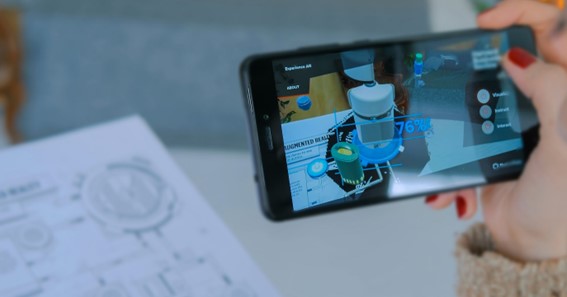Augmented Reality (AR) is a transformative technology that overlays digital information in the real world, creating an immersive and interactive experience. It has applications in numerous fields, from gaming and entertainment to education and healthcare. But how does AR work? Let’s delve into the fundamentals of this intriguing technology.
What is Augmented Reality?
At its core, AR is about enhancing our perception of reality. Unlike Virtual Reality (VR) which immerses users in a completely digital environment, AR superimposes digital elements – such as images, sounds, or other data – onto the real world. This blend of physical and virtual realities creates a unique ‘mixed reality’ where users can interact with real and virtual objects.
AR differs significantly from Virtual Reality (VR). While VR immerses users in a completely digital environment, disconnecting them from the physical world, AR enhances the real world by adding to it. This allows users to stay connected and interact with their surroundings while also experiencing digital enhancements.
All forms of extended reality (XR), however, raise privacy and liability concerns. An attorney practicing XR law can help organizations ensure their use of these technologies training or skill development remain compliant.
Key Components of Augmented Reality
Several key components make AR work:
AR Devices
AR experiences can be delivered through various AR devices, including smartphones, tablets, smart glasses, and headsets. These devices are equipped with sensors, cameras, and processors that capture, analyze, and interpret data from the real world.
Sensors and Cameras
Sensors and cameras gather information about the user’s interaction with the real world. For instance, they detect the position and orientation of the user’s device, track movements, and capture images of the surrounding environment.
Processing
Once the data is collected, it’s processed in real-time to determine what AR content should appear and where it should be placed in the real world. This involves complex algorithms and computer vision techniques to map the physical environment and overlay digital content accurately.
Projection
This is the stage where the digital content is rendered onto the user’s field of view. Depending on the device, this could involve projecting digital images onto glasses or displaying them on a screen.
How Augmented Reality Works?
Here is a step-by-step explanation of how AR works:
- Data Capture: AR starts with a camera-equipped device, such as a smartphone, a tablet, or smart glasses. The device’s camera captures the user’s environment.
- Image Processing: Once the data about the environment is captured, it is processed by the AR software. Computer Vision, a field of Artificial Intelligence, plays a crucial role in this step. It helps the software to understand the environment by identifying objects, landscapes, points of interest, etc.
- Positioning: After processing the image, the software must determine where to place the augmented content in the user’s field of view. This is done using sensors in the device, such as the accelerometer, gyroscope, and compass, which measure the orientation and location of the device.
- Rendering: Once the software has processed the environment and determined the placement of the digital content, it renders the AR elements onto the user’s display. The user sees these elements as present in their real-world environment.
- Interaction: Depending on the complexity of the AR system, users may be able to interact with the virtual elements. For example, they can move a virtual object, trigger actions by touching virtual buttons, or explore additional information by focusing on certain points of interest.
Augmented Reality Simulations: Immersive Learning Experiences for Skill Development
Understanding Augmented Reality Simulations
AR simulations blend virtual elements with our physical environment, creating a ‘mixed reality’ where users can interact with both. Unlike Virtual Reality (VR), which fully immerses users in a digital world, AR allows users to remain aware of and interact with their surroundings, providing a more realistic and practical learning experience.
The Power of AR in Learning and Skill Development
AR simulations offer numerous benefits for learning and skill development. Here are some key advantages:
Immersive Learning
AR creates immersive learning environments that engage learners on a whole new level. By visualizing information in 3D and interacting with virtual objects, learners can gain a deeper understanding of complex concepts that are difficult to grasp through traditional learning methods.
Safe Practice Environment
AR simulations provide a safe environment for learners to practice skills without the risk of real-world consequences. This is especially beneficial in fields like medicine, aviation, or engineering, where mistakes can have serious repercussions. For example, medical students can practice surgical procedures on a virtual patient before performing them on a real one.
Instant Feedback
AR simulations can provide instant feedback, allowing learners to assess their performance and learn from their mistakes in real-time. This immediate feedback loop accelerates learning and reinforces correct techniques and procedures.
Customizable Learning Experience
AR simulations can be tailored to individual learners’ needs and pace, offering a personalized learning experience. For instance, Arduino can be used in the prototyping and experimentation phases of AR projects. It is user-friendly and accessible, making it suitable for rapid prototyping and testing of various components including Arduino sensors. Learners can repeat simulations as many times as needed until they master a skill, enhancing knowledge retention and building confidence.
Real-World Applications of AR Simulations
AR simulations are being used across various sectors for skill development. In healthcare, AR simulates surgeries, enabling medical students to practice and refine their skills. In aviation, pilots use AR simulations for flight training, learning how to respond to different scenarios in a controlled environment.
In the corporate world, AR is used for employee training, from onboarding new hires to upskilling existing staff. AR simulations can recreate realistic workplace scenarios, helping employees develop essential skills like problem-solving, decision-making, and teamwork.
The education sector is also embracing AR. Teachers use AR simulations to bring subjects to life, making learning more engaging and enjoyable for students. For example, a history lesson could include an AR simulation of a historical event, providing students with a more vivid and memorable learning experience.
Click here – What Is A Strip Diagram?
The Future of AR Simulations in Learning
We can expect AR simulations to become even more sophisticated and widespread as technology advances. We might see fully immersive AR classrooms where students can explore the solar system, walk through ancient civilizations, or dive into the human body. AR could be used in the workplace to simulate challenging scenarios, preparing employees for anything they might face on the job.
Conclusion
Augmented Reality is a transformative technology that enhances our interaction with the real world by adding digital elements. As advancements in AR technology continue, it is set to revolutionize numerous industries, changing how we play, shop, learn, and work.
AR simulations offer immense potential for learning and skill development. By providing immersive, interactive, and customizable learning experiences, AR can revolutionize how we acquire and refine skills, improving education and training. As we continue to embrace and innovate with this technology, the possibilities for learning are virtually limitless.






